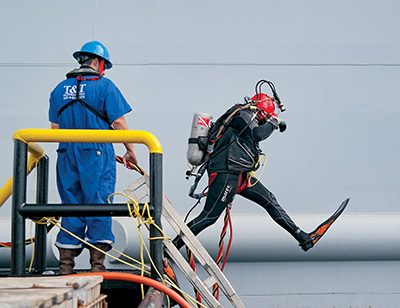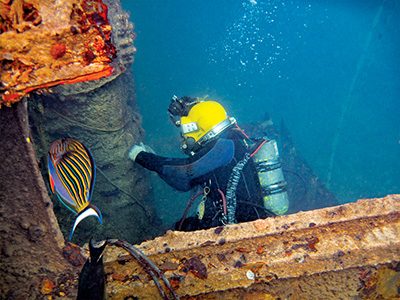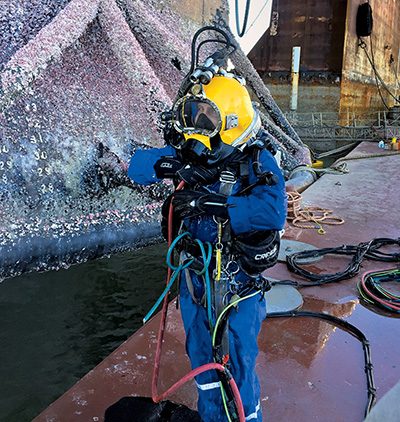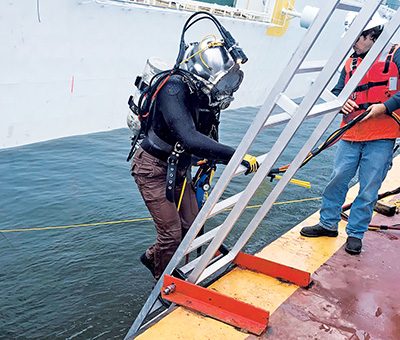FOUR SCUBA DIVERS BECAME TRAPPED and died while working in an offshore pipeline in 2022. This incident was a harsh reminder that commercial diving is a “hazardous occupation that presents many dangers that far exceed the risks in sport diving,” as highlighted in The Simple Guide to Commercial Diving. The typical risks in recreational diving, such as decompression sickness and pressure-related injuries to the ears and lungs, are still present, but commercial divers regularly face additional hazards — such as zero visibility, contaminated water, and pressure differentials — all while simultaneously operating industrial tools.
Specialized training and experience are required to enter the commercial diving field. Factors that distinguish commercial diving from recreational diving include equipment, procedures, and the size of the crew and support personnel.
Since 1968 the Association of Diving Contractors International (ADCI) has focused on continuously improving commercial diving safety by developing and advancing industrywide standards. The ADCI is a multidisciplinary organization with senior leaders from the dive business, educational, manufacturing, and medical communities. They work closely with state and federal regulatory agencies and industry stakeholders to develop consensus standards for safe underwater work. These standards often exceed those in the Code of Federal Regulations for commercial diving operations. The Coast Guard, Occupational Safety and Health Administration (OSHA), and Army Corps of Engineers regularly cite ADCI’s International Consensus Standards for Commercial Diving and Underwater Operations as the authoritative set of best practices.


A fundamental rule is that commercial diving does not typically use scuba. If an operation requires scuba, multiple layers of risk mitigation are necessary to ensure commercial diver safety and prevent loss of life. While surface-supplied air and mixed-gas equipment and procedures comprise most of commercial diving, ADCI recently refocused on further mitigating scuba risks during commercial diving operations.
“There has been a rash of scuba-related fatalities related to ship husbandry and other commercial diving work that prohibits scuba and requires surface-supplied diving operations,” ADCI Executive Director Phil Newsum said in a recent interview.
Based on a review of dive incidents, an ADCI focus group recommended additional safety measures for commercial divers using scuba. Their guidelines include requiring full-face masks with communications and primary and emergency air supplies for each diver routed through a manifold or switch block with separate gauges for each cylinder. The recommended dive team has at least four qualified commercial divers, including surface support from an ADCI-certified dive supervisor and a designated tender for the diver. The group also suggests that scuba divers should not use hydraulic, air, or battery-powered tools.


Hazards and Risk Mitigation
Several underwater tasks and situations — such as differential pressure, uncontrolled ascents using underwater inflatable lifting devices, and underwater welding and burning — can pose a hazard to commercial divers. Differential pressure, commonly known as Delta P, occurs when there is a pressure difference between two points in a system that can injure and trap divers, such as when working around pipelines and dams.
Newsum pointed out that using underwater inflatables can be hazardous, with the possibility of a diver’s uncontrolled ascent or an object being lifted or moved within the water column. He added that underwater welding and burning requires proper risk assessment.
“It can produce hydrogen and oxygen mixtures that are highly explosive,” he said. “Closed compartments, structures, or pipelines subjected to the heat of underwater burning or welding need to be flooded or purged with water and vented. If not, flammable gases or hydrocarbons can ignite.”
Professionally trained, properly equipped, and experienced commercial divers can safely perform underwater work despite the hazards. Beyond training and equipment, commercial dive operations also need a thoroughly developed safety plan and daily job hazard analyses. One such example is the MVGolden Ray, a 656-foot (200-meter) cargo ship that capsized in 2019 in St. Simons Sound, Georgia, where commercial divers safely executed more than 1,000 dives.
The shipwreck removal involved underwater thermal cutting and welding operations. Procedures for that work and for diving in contaminated water with limited visibility and strong currents were necessary. The team used surface-supplied air equipment with communications to a support team on deck for up to eight divers and an ADCI-certified dive supervisor. The support vessel had a recompression chamber and backup dive systems ready as a contingency, and these had daily inspections by the dive supervisor with oversight by the company and Coast Guard safety officers.
Commercial Dive Training
Anyone desiring to work in the commercial diving industry must complete commercial diver training to obtain entry-level certification as a dive tender. Commercial dive training instructs a diver how to get to and from an underwater work site and may also include hydraulic and pneumatic tools, nondestructive testing, underwater welding and burning, chamber operations, equipment maintenance, rigging, and multiple other necessary skills.
Commercial divers must be able to respond to a dive emergency, so they maintain first aid, CPR, and oxygen administration certifications. They must also complete OSHA-required training to conduct contaminated-water dive operations.
“Commercial diver training, unlike recreational diver training, covers the full gamut of hazards of working underwater with various types of equipment on different projects,” Newsum noted. It takes about six months but can be longer depending on the qualifications and certifications that graduates require.
They may also need a more thorough medical examination and a higher level of fitness to dive than a recreational diver would seek. It’s also vital that commercial divers “understand the hazards and risks they will face during their work, both those associated with diving itself and those connected with the marine construction and maintenance tasks they will be expected to complete underwater,” Newsum explained.
A commercial diving course, while comprehensive, is only the beginning of the training and experience required for graduates. They also need years of hands-on experience and additional training to succeed in the industry.
Recreational dive certifications do not qualify a diver to conduct commercial diving work. In letters to the ADCI, PADI President and CEO Drew Richardson wrote, “PADI courses (at any level) are not intended, nor designed, to prepare people for commercial diving activities.” Tom Leaird, CEO of Scuba Educators International, noted that “recreational dive training is no substitute for commercial dive training.”
Crew, Equipment, and Safety
A commercial diver using surface-supplied air has support on the surface from a dive tender who manages the diver’s umbilical. A standby diver is always ready to enter the water and respond if the working diver needs support. A designated dive supervisor manages the dive crew, maintains constant communications to direct the diver, keeps a written log, and monitors dive time and working depths to manage decompression.
All dive support personnel focus on the diver’s safety, and if the diver loses communications or has any issues such as entrapment or loss of breathing gas, the standby diver enters the water to assist the diver, and the dive ends. All dive crew members are empowered to stop the work and recall the diver.
The typical surface-supplied dive package includes compressors, breathing-air filters, volume tanks, a control manifold with pressure and depth gauges, and a communications system. Hookah systems, which ADCI defines as “a dangerous combination of scuba and surface-supplied-air systems with none of the safety components of either,” are prohibited. ADCI guidelines indicate that “hookah systems do not have voice communications with topside, depth monitoring capability, bailout switch-over capability, and umbilical markings for distance.”
Divers should always have inspected helmets with video, light, communications, nonreturn valves, and a high-pressure backup cylinder in the event of compressor failure. In addition to their own bailout cylinder, each diver has a properly marked umbilical comprised of a breathing-gas hose, pneumofathometer hose, strength member, and communications and video cables.
OSHA rules require a deck recompression chamber for any dives more than 100 feet and during decompression diving. All equipment should have a comprehensive maintenance routine and be tested before each operation. Compressor air quality, for example, is required to be tested at least every six months.
This minimum dive crew and equipment is needed to get the diver safely to the underwater worksite. Once there, the commercial diver must be able to operate pneumatic, hydraulic, burning, welding, and other equipment, such as nondestructive testing instruments. Salvage divers, for example, should be proficient in using a hot-tapping system to install hydraulic submersible pumps to recover oil from a sunken ship.
A trained, certified, experienced, and equipped commercial diving company should manage commercial operations. The company should be an ADCI member, which requires regular auditing by a third party experienced in commercial diving operations.
Before conducting dives, all equipment must be inspected and tested. Equipment maintenance records should be up-to-date to document equipment readiness. A written dive plan that meets ADCI, Coast Guard, and OSHA standards should be in place before the dive operation, plus a job hazard analysis must be conducted with all crew members before each daily dive operation and when operational conditions change.
Commercial diving operations are often complex endeavors, but these few basic guidelines promote the safety of commercial divers. AD
© Alert Diver — Q4 2023